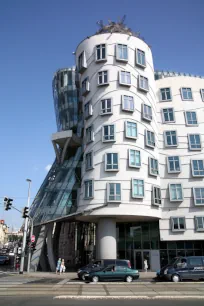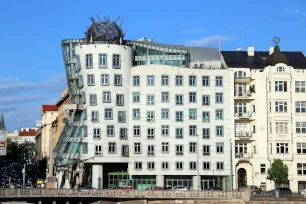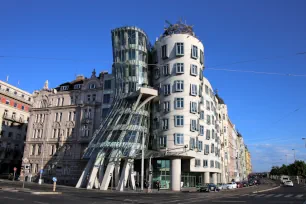Dancing House is a modern building designed in deconstructionist style by Vlado Milunić and Frank O. Gehry. It is the most famous modern building in Prague, a city better known for its historic architecture.

Background
Zagreb-born Czech architect Vlado Milunic first launched the idea for this modern building in the mid 1980s. At that time, he lived in a building adjacent to a vacant plot along the Vltava River (better known by its German name Moldau); the original Renaissance-style building had been destroyed during WWII. By coincidence, Václav Havel – at the time a dissident but later the first Czech President – lived in the same building as the architect. Milunić pitched his idea of building a modern structure on the neighboring vacant plot to Havel, who supported it, hoping it would become a cultural center.
After the Velvet Revolution, Milunić found financial support from the Nationale Nederlanden Bank to build his modern structure, but Nationale Nederlanden asked Milunić to partner with a renowned architect.


The first choice was French architect Jean Nouvel, but he declined since he deemed the plot too small for two architects. Canadian-born architect Frank O. Gehry however was willing to cooperate after, in 1992, he saw some of Milunić’s sketches of the building.
Fred and Ginger
The building portrays two people dancing, hence the original name of the edifice: Fred and Ginger, after the famous dance couple Fred Astaire and Ginger Rogers. The building soon became known as the ‘dancing house’. Milunić describes the building as a dance performed after the Velvet Revolution.
Architecture
The construction of the building in what is described as a deconstructionist style – the architects themselves consider the style ‘new Baroque’ – created quite a stir since the modern building starkly contrasts with its surroundings, both in its architecture and in its use of materials. Opposition against the building continued even after it was completed in 1996, but eventually Prague citizens have come to accept and even appreciate the building.

